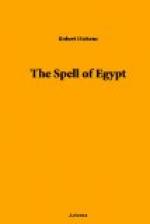It is not easy to convey by any description the impression this marvellous statue makes. Many of us love our dogs, our horses, some of us adore our cats; but which of us can think, without a smile, of worshipping a cow? Yet the cow was the Egyptian Aphrodite’s sacred animal. Under the form of a cow she was often represented. And in the statue she is presented to us as a limestone cow. And positively this cow is to be worshipped.
She is shown in the act apparently of stepping gravely forward out of a small arched shrine, the walls of which are decorated with brilliant paintings. Her color is red and yellowish red, and is covered with dark blotches of a very dark green, which look almost black. Only one or two are of a bluish color. Her height is moderate. I stand about five foot nine, and I found that on her pedestal the line of her back was about level with my chest. The lower part of the body, much of which is concealed by the under block of limestone, is white, tinged with yellow. The tail is red. Above the head, open and closed lotus-flowers form a head-dress, with the lunar disk and two feathers. And the long lotus-stalks flow down on each side of the neck toward the ground. At the back of this head-dress are a scarab and a cartouche. The goddess is advancing solemnly and gently. A wonderful calm, a matchless, serene dignity, enfold her.
In the body of this cow one is able, indeed one is almost obliged, to feel the soul of a goddess. The incredible is accomplished. The dead Egyptian makes the ironic, the skeptical modern world feel deity in a limestone cow. How is it done? I know not; but it is done. Genius can do nearly everything, it seems. Under the chin of the cow there is a standing statue of the King Mentu-Hotep, and beneath her the king kneels as a boy. Wonderfully expressive and solemnly refined is the cow’s face, which is of dark color, like the color of almost black earth—earth fertilized by the Nile. Dignified, dominating, almost but just not stern, strongly intelligent, and, through its beautiful intelligence, entirely sympathetic ("to understand all, is to pardon all"), this face, once thoroughly seen, completely noticed, can never be forgotten. This is one of the most beautiful statues in the world.
When I was at Deir-el-Bahari I thought of it and wished that it still stood there near the Colonnades of Thebes under the tiger-colored precipices. And then I thought of Hatshepsu. Surely she would not brook a rival to-day near the temple which she made—a rival long lost and long forgotten. Is not her influence still there upon the terraced platforms, among the apricot and the white columns, near the paintings of the land of Punt? Did it not whisper to the antiquaries, even to the soldiers from Cairo, who guarded the Vache-Hathor in the night, to make haste to take her away far from the hills of Thebes and from the Nile’s long southern reaches, that the great queen might once more reign alone? They obeyed. Hatshepsu was appeased. And, like a delicate woman, perfumed and arranged, clothed in a creation of white and blue and orange, standing ever so knowingly against a background of orange and pink, of red and of brown-red, she rules at Deir-el-Bahari.




